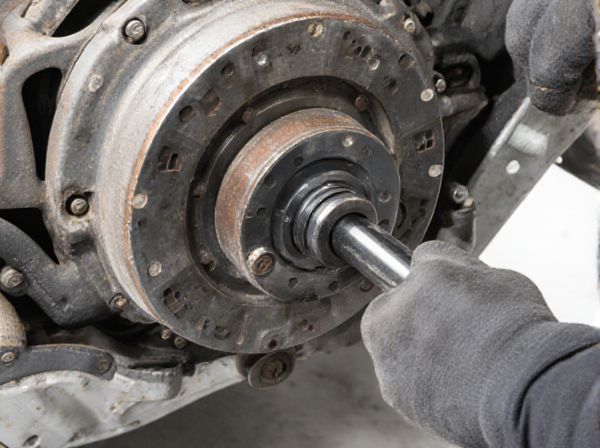
Photo illustration: Deactivated Camshaft vs Fixed Camshaft
A deactivated camshaft allows your engine to switch between active and inactive modes, improving fuel efficiency by disabling some valves during low-load conditions. In contrast, a fixed camshaft has a constant valve timing, offering simplicity and reliability but less flexibility in optimizing performance and fuel economy. Choosing between them depends on whether you prioritize dynamic engine control or straightforward mechanical design.
Table of Comparison
| Feature | Deactivated Camshaft | Fixed Camshaft |
|---|---|---|
| Functionality | Variable valve timing with cylinder deactivation for fuel efficiency | Constant valve timing, no variation during engine operation |
| Fuel Efficiency | Improves fuel economy by reducing active cylinders under light load | Standard fuel consumption, less efficient under partial load |
| Performance | Optimized for both power and economy, switches modes dynamically | Consistent performance but limited adaptability |
| Complexity | Mechanically and electronically complex due to activation systems | Simple mechanical design with fewer components |
| Maintenance | Higher maintenance due to additional valves and actuators | Lower maintenance with fewer moving parts |
| Typical Use Cases | Modern engines aimed for efficiency and emissions reduction | Older or budget vehicles emphasizing reliability |
Introduction to Camshaft Configurations
Deactivated camshaft technology allows variable valve timing by selectively disabling certain cam lobes to improve fuel efficiency and reduce emissions, while fixed camshafts maintain a constant valve timing structure throughout engine operation. This distinction affects engine performance, efficiency, and responsiveness by adapting valve lift and timing to driving conditions or enforcing a steady mechanical profile. Understanding these camshaft configurations is crucial for optimizing engine design tailored to specific power and economy demands.
What is a Fixed Camshaft?
A fixed camshaft is a fundamental engine component that controls valve timing with a set profile, maintaining consistent valve operation throughout engine cycles. Unlike deactivated camshafts, it does not adjust or deactivate cylinders for fuel efficiency, providing reliable performance but potentially less optimal fuel economy. Fixed camshafts are commonly used in traditional internal combustion engines where simplicity and durability are prioritized.
Understanding Deactivated Camshaft Technology
Deactivated camshaft technology enhances engine efficiency by selectively disabling valve operation in cylinders under light load conditions, reducing fuel consumption and emissions. Unlike fixed camshafts that maintain continuous valve timing, deactivated camshafts use hydraulic or electronic actuators to modulate valve lift for improved control. This technology enables dynamic adjustment of valve events, optimizing performance without compromising power during demand spikes.
Key Differences: Deactivated vs Fixed Camshaft
Deactivated camshafts offer variable valve timing by selectively disabling some valves to improve fuel efficiency and reduce emissions, unlike fixed camshafts that maintain a constant valve operation for consistent performance. The key difference lies in the ability of deactivated camshafts to adjust valve lift and duration dynamically, enhancing engine adaptability across different driving conditions. Fixed camshafts provide simpler mechanics with fewer moving parts, resulting in reliable but less flexible engine behavior compared to the advanced control offered by deactivated camshafts.
Performance Impacts of Each Camshaft Type
Deactivated camshafts improve fuel efficiency by reducing valve operation during low-load conditions, though they may slightly decrease maximum engine power due to limited valve overlap. Fixed camshafts provide consistent valve timing optimized for peak performance, resulting in better throttle response and higher horsepower output at the expense of increased fuel consumption. The choice between deactivated and fixed camshafts impacts engine tuning strategies, balancing efficiency with power based on driving demands.
Fuel Efficiency Comparison
Deactivated camshaft technology improves fuel efficiency by selectively disabling valve operation in cylinders during low-load conditions, reducing fuel consumption compared to fixed camshaft systems that maintain constant valve timing. Fixed camshaft engines often exhibit higher fuel usage because they lack the flexibility to adjust valve events dynamically, resulting in less optimized combustion cycles. Studies show that engines with deactivated camshafts can achieve fuel savings of up to 10-15% over traditional fixed camshaft engines under typical driving scenarios.
Reliability and Maintenance Factors
Deactivated camshafts offer improved fuel efficiency by selectively disabling valve operation, but their complexity can lead to increased maintenance and potential reliability issues compared to fixed camshafts, which have simpler, fixed valve timing for consistent performance and lower maintenance demands. Fixed camshafts benefit from proven durability due to fewer moving parts and less electronic control, resulting in lower repair costs and longer service intervals. The choice between deactivated and fixed camshafts should consider trade-offs between improved efficiency and the potential need for more frequent or complex maintenance.
Cost Implications: Initial and Long-Term
Deactivated camshaft systems typically involve higher initial costs due to advanced technology and complex components compared to fixed camshafts, which are simpler and cheaper to manufacture. Over the long term, deactivated camshafts can offer cost savings through improved fuel efficiency and reduced emissions, potentially lowering fuel expenses and maintenance frequency. However, maintenance and repair costs for deactivated camshafts might be higher if the system's actuators or sensors fail, unlike fixed camshafts, which have fewer failure points and generally lower repair expenses.
Applications in Modern Engines
Deactivated camshaft technology enhances fuel efficiency and reduces emissions in modern engines by selectively disabling valve operation during low-load conditions, commonly found in V6 and V8 engines with variable displacement systems. Fixed camshafts, predominantly used in conventional engines, provide consistent valve timing suited for standard performance but lack the adaptability needed for optimized fuel consumption in fluctuating driving scenarios. Advanced engines increasingly adopt deactivated camshafts to meet stringent environmental regulations and improve overall engine efficiency without sacrificing power output.
Which Camshaft Type is Right for You?
Choosing between a deactivated camshaft and a fixed camshaft depends on your driving needs and fuel efficiency priorities. A deactivated camshaft optimizes engine performance by disabling certain valves at low RPMs, enhancing fuel economy and reducing emissions during everyday driving. A fixed camshaft offers consistent valve timing, providing reliable power and simplicity ideal for performance-focused or heavy-duty vehicles where fuel savings are less critical.
 caratoz.com
caratoz.com